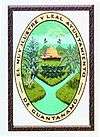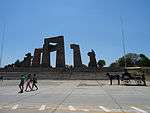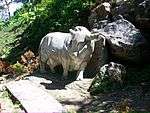Guantánamo
Guantánamo (UK: /ɡwænˈtænəmoʊ/,[4] US: /ɡwɑːnˈtɑːn-/,[5][6] Spanish: [ɡwanˈtanamo]) is a municipality and city in southeast Cuba and capital of Guantánamo Province.
Guantánamo | |
|---|---|
 Main street in front of post office | |
 Seal | |
.png) Guantánamo municipality (red) within Guantánamo Province (yellow) and Cuba | |
| Coordinates: 20°08′12″N 75°12′50″W | |
| Country | Cuba |
| Province | Guantánamo |
| Established | 1797[1] |
| Area | |
| • City | 741.4 km2 (286.3 sq mi) |
| Elevation | 46 m (151 ft) |
| Population (2011)[3] | |
| • City | 210,407 |
| • Density | 280/km2 (740/sq mi) |
| • Metro | 216,734 |
| Demonym(s) | Guantanamero/ra |
| Time zone | UTC-5 (EST) |
| Postal code | 95100 |
| Area code(s) | +53 21 |
Guantánamo is served by the Caimanera port near the site of a U.S. naval base. The area produces sugarcane and cotton wool. These are traditional parts of the economy.
History
The city was founded in 1797[1] in the area of a farm named Santa Catalina. The toponym "Guantánamo" means, in Taíno language, "land between the rivers".[7]
Geography
The municipality is mountainous in the north, at Alejandro de Humboldt National Park, where it overlays the Sierra Maestra (mountains), and borders the Windward Passage of the Caribbean Sea in the south. It is crossed by the Bano, Guantánamo, Yateras, Guaso, San Andrés, and Sabanalamar rivers. The city is spread with a square plan and is crossed in the middle by the Carretera Central highway. Guantánamo Bay is a natural harbour south of it.
The municipality borders with El Salvador, Niceto Pérez, Caimanera, Yateras, Manuel Tames, and Sagua de Tánamo; this one in Holguín Province. It includes the villages of Argeo Martínez, Arroyo Hondo, Glorieta, Las Lajas, and Paraguay.
Prior to 1976 it was divided into the barrios and villages Arroyo Hondo, Baitiquirí, Bano, Bayate, Caimanera, Camarones, Caridad, Corralillo, Cuatro Caminos, Filipinas, Glorieta, Gobierno, Guaso, Hospital, Indios, Isleta, Jaibo Abajo, Las Lajas, Macurijes, Mercado, Ocujal, Parroquia, Palma de San Juan, Rastro, Tiguabos, and Vínculo.[1] After 1976 reform part of municipal territory was split in the municipalities of El Salvador, Niceto Pérez, Caimanera, and San Antonio del Sur.[7]
United States Naval Base
About 15 km away from the city lies the Guantánamo Bay, a superior natural harbor which has been utilized by the United States since 1898, when it was captured from Spain in the Battle of Guantánamo Bay. In 1903 Cuba leased it to the U.S. as it had committed to in the Cuban–American Treaty of Relations, and remains the site of a US Navy base, as well as the Guantanamo Bay detention camp.
Demographics
In 2004, the municipality of Guantánamo had a population of 244,603.[3] With a total area of 741 km2 (286 sq mi),[2] it has a population density of 330.1/km2 (855/sq mi).
Famous Guantanameros
Notable natives of Guantánamo include athletes Joel Casamayor, Erislandy Lara, Yuriorkis Gamboa, Yumileidi Cumbá, Jaime Jefferson, Yargelis Savigne, Dayron Robles, Luis Delís, Cuban-American gymnast Annia Hatch, musician Diamela del Pozo, and cosmonaut Arnaldo Tamayo Méndez.
Transport
The city is served by the Carretera Central highway, and is the eastern terminus of the A1 motorway, that is mainly under construction and will link Guantánamo with Havana. The city airport "Mariana Grajales" is located near the villages of Las Lajas and Paraguay.
The song "Guantanamera"
"Guantanamera" (Spanish: "from Guantánamo [feminine]", thus "woman from Guantánamo") is perhaps the best known Cuban song and that country's most noted patriotic song. In 1966, a version by American vocal group The Sandpipers, based on an arrangement by Pete Seeger, became an international hit. The song was later also one of Cuban superstar singer Celia Cruz's biggest hits.
Gallery
 Hotel Washington (1974)
Hotel Washington (1974)- The Cathedral
 Plaza de la Revolución
Plaza de la Revolución A sculpture of an ox in the "Zoológico de Piedra" (i.e.: "Stone Zoo")
A sculpture of an ox in the "Zoológico de Piedra" (i.e.: "Stone Zoo")
See also
References
- Guije.com. "Guantánamo" (in Spanish). Retrieved 2007-10-05.
- Statoids. "Municipios of Cuba". Retrieved 2007-10-05.
- Atenas.cu (2004). "2004 Population trends, by Province and Municipality" (in Spanish). Archived from the original on 2007-09-27. Retrieved 2007-10-05.
- "Guantánamo Bay". Lexico UK Dictionary. Oxford University Press. Retrieved 28 July 2019.
- "Guantánamo". The American Heritage Dictionary of the English Language (5th ed.). Boston: Houghton Mifflin Harcourt. Retrieved 28 July 2019.
- "Guantánamo". Collins English Dictionary. HarperCollins. Retrieved 28 July 2019.
- (in Spanish) Guantánamo on EcuRed
Further reading
- Jonathan M. Hansen, Guantánamo: An American History. New York: Hill and Wang, 2011.
External links
| Wikimedia Commons has media related to Guantánamo. |